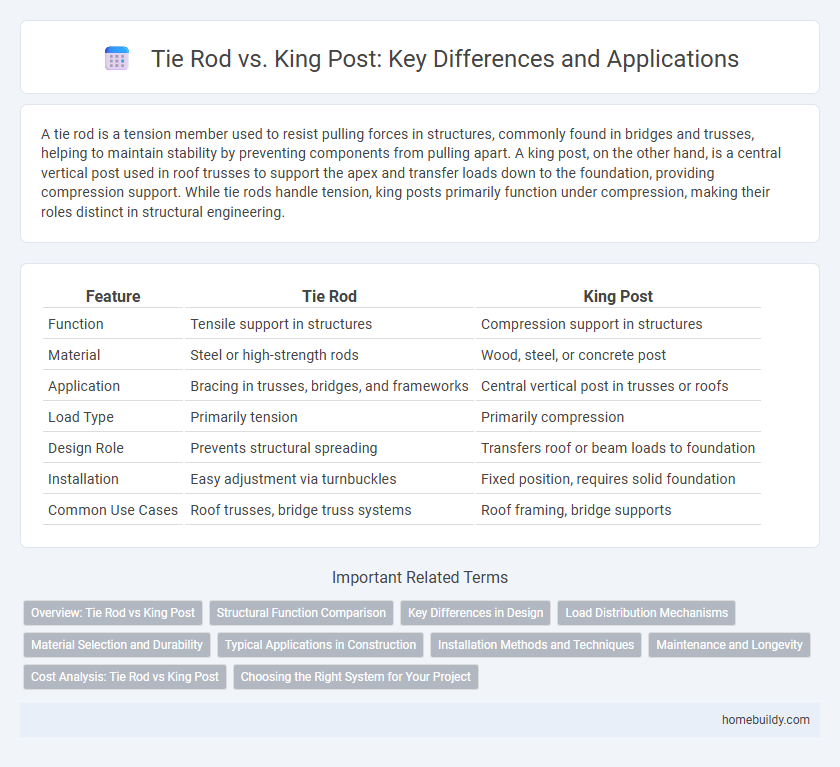A tie rod is a tension member used to resist pulling forces in structures, commonly found in bridges and trusses, helping to maintain stability by preventing components from pulling apart. A king post, on the other hand, is a central vertical post used in roof trusses to support the apex and transfer loads down to the foundation, providing compression support. While tie rods handle tension, king posts primarily function under compression, making their roles distinct in structural engineering.
Table of Comparison
| Feature | Tie Rod | King Post |
|---|---|---|
| Function | Tensile support in structures | Compression support in structures |
| Material | Steel or high-strength rods | Wood, steel, or concrete post |
| Application | Bracing in trusses, bridges, and frameworks | Central vertical post in trusses or roofs |
| Load Type | Primarily tension | Primarily compression |
| Design Role | Prevents structural spreading | Transfers roof or beam loads to foundation |
| Installation | Easy adjustment via turnbuckles | Fixed position, requires solid foundation |
| Common Use Cases | Roof trusses, bridge truss systems | Roof framing, bridge supports |
Overview: Tie Rod vs King Post
Tie rods and king posts are essential structural components used in architectural and engineering designs to provide support and stability. Tie rods are tension members that resist pulling forces, commonly utilized in bridges and roofs to hold components together; king posts are vertical posts that provide central support in trusses, transferring loads from the apex to the base. Understanding the differences in load-bearing behavior and applications ensures optimal material use and structural integrity in construction projects.
Structural Function Comparison
Tie rods primarily resist tensile forces, providing lateral stability by preventing structural elements from spreading apart under load. King posts act as central compression members, transferring vertical loads from a beam to the foundation while supporting the structural framework. The key difference lies in tie rods' tension role versus king posts' compression function within truss systems.
Key Differences in Design
Tie rods are slender, tension members designed to resist pulling forces, typically made from round steel bars or rods, and are commonly used in truss structures to provide stability. King posts consist of a central vertical post with two diagonal struts, forming a triangular support that carries compressive forces and acts as a key component in king post trusses. The key difference in design lies in the tie rod's function as a tension element versus the king post's role in compression, influencing their structural applications and load distribution.
Load Distribution Mechanisms
Tie rods transfer tensile loads directly along their length, efficiently handling tension forces by anchoring structural components and maintaining stability. King posts distribute loads through compression, transferring weight from the apex of a structure downward to the base, often supporting beams or trusses. The load distribution mechanism in tie rods emphasizes tensile strength, while king posts primarily rely on compressive force management within architectural frameworks.
Material Selection and Durability
Tie rods are commonly made from high-strength steel alloys that offer excellent tensile strength and corrosion resistance, making them ideal for applications requiring durability under dynamic loads. In contrast, king posts often utilize materials such as timber or wrought iron, which may be more susceptible to environmental degradation and require frequent maintenance. The superior material properties of steel tie rods contribute to longer service life and reduced structural failures compared to king posts.
Typical Applications in Construction
Tie rods are commonly used in construction for tension support in trusses, bridges, and roof structures, providing stability against lateral forces. King posts serve a similar function but are primarily employed in smaller-span roof trusses where compressive loads dominate. Tie rods excel in applications requiring adjustable tension and resistance to tensile stresses, while king posts are favored for their simplicity in short-span timber framing.
Installation Methods and Techniques
Tie rod installation involves securing the rod between two anchor points using threaded ends and turnbuckles for precise tension adjustment, ensuring structural stability. King post installation requires anchoring the vertical post to the foundation or beam, followed by attaching tension cables or rods diagonally to distribute loads evenly. Both methods demand accurate alignment and tension calibration but differ in anchorage type and load transfer mechanics.
Maintenance and Longevity
Tie rods require less frequent maintenance compared to king posts due to their simpler design and fewer moving parts. The durability of tie rods results in a longer lifespan, reducing the need for replacements or repairs. King posts often demand more rigorous inspections and upkeep to maintain structural integrity over time.
Cost Analysis: Tie Rod vs King Post
Tie rods offer a cost-effective solution compared to king posts, largely due to simpler manufacturing and easier installation processes that reduce labor expenses. Material costs for tie rods tend to be lower, as they require less steel and minimal fabrication, whereas king posts often involve more complex welding and heavier components. Maintenance and replacement costs also favor tie rods, providing long-term economic advantages in structural frameworks.
Choosing the Right System for Your Project
Choosing the right system between a tie rod and a king post depends on the structural requirements and load distribution of your project. Tie rods provide tension support ideal for spanning large distances with minimal material, while king posts offer compressive strength suited for shorter, heavier loads. Evaluating factors such as span length, load type, and aesthetic preferences ensures optimal performance and durability in your construction design.
tie rod vs king post Infographic

 homebuildy.com
homebuildy.com